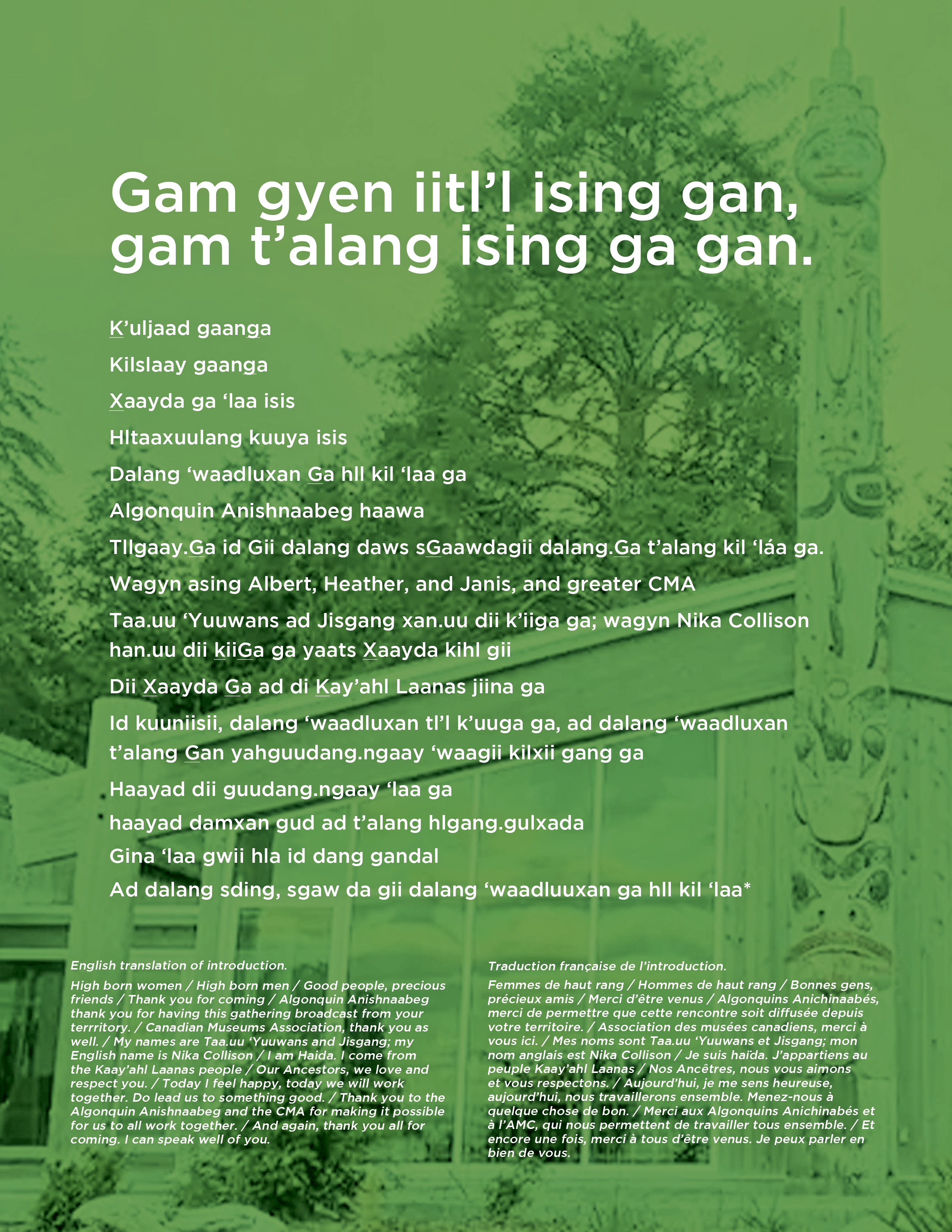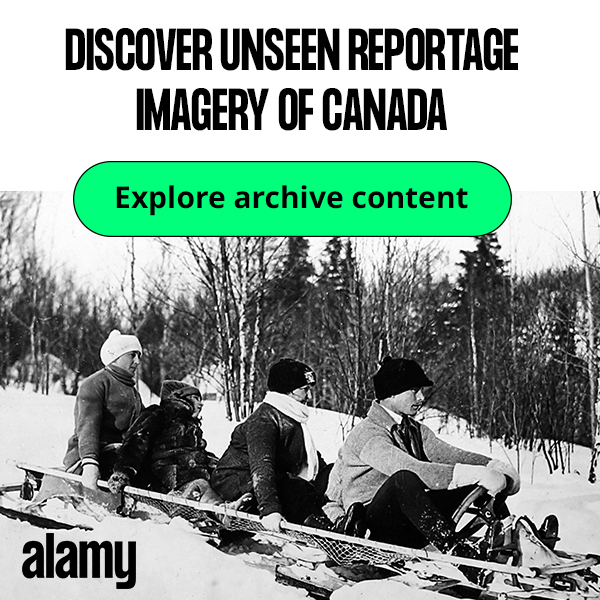Nothing About Us Without Us
Nika Collison
This presentation was originally delivered as the opening keynote address at the CMA 2023 National Conference. It has been edited and significantly shortened for length and format.
Being both Haida and ED/curator of the Haida Gwaii Museum, I’ve enjoyed unique opportunities that stem from making my life my work and my work my life. I’m privileged to work alongside my Nation to uphold Xaayda Ga Xaaynang.ngaay, Haida ways of being, and, to work in this manner with global museums.
One of the main laws of the Haida Nation is Yahguudang — the act of paying Respect — meaning respect for all things: land, water and air; the Supernatural; our Ancestors and each other. As my Aunty GwaaGanad taught me, it is only when we show such respect, that we can be worthy of respect ourselves.
From this law, and many others of our Nation, comes the privilege of laa guu ga kanhllns, or responsibility. As museum professionals and as human beings, we carry the responsibility to affect society by mainstreaming Canada’s dark history with Indigenous peoples, while actively working to set things right.
In the Haida-Museum world, the path towards conciliation has been shaped by Yahguudangang. The Haida Nation sees this work, which includes repatriation, as “based upon mutual respect, co-operation and trust.” Yahguudangang is how the remains of our Ancestors have been brought home. It is how our museum was born and is what our own collection of treasures is built upon.
Yahguudangang has brought a new depth to the Haida Nation’s healing, and our ability to heal with others. It affords opportunity for western museums to become voluntary agents of change, rather than the physical evidence of Canada’s genocide against Indigenous Peoples.

Interior of Haida Gwaii Museum at Kay Llnagaay. Photo — Rolf Bettner, c. 2009. Courtesy Haida Gwaii Museum at Kay Llnagaay.
Our Ancestors surround us. We are here, knowing who we are and where we come from, because of them. For over 25 years our Nation and museum have worked to bring home over 500 of our Ancestors from museums and private homes with honour and respect. It’s cost well over a million dollars in cash, sweat-labour and in-kind donations to do this work. The majority of these costs have been born by our Nation.
How we found ourselves in this position, why we do this work, and where it is taking us (all) is a story that should be known and never forgotten.
Historically, every Haida clan had a professional Storyteller that kept our extensive histories in-tact. From this, we know histories that pre-date human occupation on this earth; that “in the beginning” it was both light and dark, and the earth was covered in water. Only the Supernaturals floated there, tired and in need of land. We know of the creation of Haida Gwaii and the mainland; the releasing of the sun, moon and stars, the bringing of salmon and fresh water to our Islands; all of this and much more, safe-kept by the Storytellers.
I am taught by my Aunty Gwaa Ganad, who learned from oral historian Nang King.aay ‘uwans James Young, that we first came out of the air but did not survive. We did not survive when we came from the earth. We as Haida today, we come from the ocean. The Supernaturals took pity on us. That is why we are here.
We have lived through millennia. Our histories recount the coming of the last ice age; times when the earth was unbearably hot; and the rising and falling waters. These histories have aided science in understanding the past. For example, science recently “discovered” that the first tree to grow on Haida Gwaii after the last ice age was the Ts’ahl, or lodgepole pine tree, just as our Ancestors said. Science helped to put a timeframe to this event, which occurred 12-14,000 years ago. About 6,500 years ago, we became people of the cedar.
How did Indigenous ancestors and belongings wind up in museums?
The first (western accepted) documentation of European and Haida encounters occurred in 1774, when the Spanish ventured into Haida waters. The British soon followed, fulfilling the prophecy of a S Gaaga, a medicinal and spiritual practitioner, who warned of the coming of the Spirit of Pestilence.
The first wave of smallpox to hit the coast is believed to have occurred in the late 1700s, with a smaller one in the early 1800s, with evidence that these epidemics were purposefully introduced.
Survivors went on to face Canada’s Indian Act, which put Indigenous Peoples on tiny, locked reserves, made us “wards of the state,” created mechanisms to divide us from our communities, and outlawed our socio-economic and legal systems. The Church also hurt our people, forming Church-run day-schools in our villages, and later joined with Canada to create the Residential School System.
It was predominantly during this period that Haida burials were desecrated and the remains of hundreds of our Ancestors were stolen, along with thousands of our belongings by various Indian agents, missionaries, anthropologists and explorers. We know of over 12,000 treasures attributed to Haida, held in over 300 global museums and universities. Most of what wasn’t stolen was handed over or sold under duress. Our way of life was outlawed, and our people faced extreme social and economic marginalization. All required our people to find ways of surviving in this new world.
Canada tried to destroy our spirit; our identity; our Haida-ness. They wanted us to forget our responsibility to Haida Gwaii, the Supernatural and each other; to forget our understanding of who we are and our place in this world. Perhaps the greatest tragedy in all of this, is, as my friend Gidansda once told me, “This is the story of the world.”
When I was recounting the real story of Canada to my then-13-year-old daughter, Gid Kuuyas, she went quiet for a long time before she spoke of the colonizers, so generously stating, “They sure had misguided minds, hey mom?”
Saahlinda Naay, Saving Things House
Amazingly, our surviving Ancestors not only survived, many thrived, and I know they worked very hard so that we could be here today. They ensured our knowledge and practices were passed down, often using western practices as a guide. What could not be passed down orally was preserved through our Ancestors choosing to work with anthropologists to record our history.
Drawing on the gifts provided by both living knowledge holders and those living before us, a new generation of artists began to carve out a new chapter in our history, creating pivotal works such as the first monumental poles to be raised using Haida law and ceremony in almost 100 years. Weavers not only kept the art of weaving and textiles alive, they kept their use alive. With this strong re-integration of art as social function, Haida art began its ascent back into our daily lives. As the art returned, so did our identity, and our journey back to sovereignty and self-determination.
Saahlinda Naay, Saving Things House, also known as the Haida Gwaii Museum, is one of the earliest acts of Tl’l Yahda, “Making Things Right” between Indigenous Peoples and mainstream museums. A vision of both Haida citizens and Canadians residing on our Islands, our museum opened in 1976 in Kay Llnagaay, an ancient village dating back to the time of the Supernaturals. This is where my clan came out of the ocean.
Yahguudangang — the Act of Paying Respect
Our museum operates in line with Haida society. We seek direction from our Elders and Leaders on proper conduct, and in the caring and sharing of our treasures. For example, we would never have raised these three poles in our museum without the permissions of the K’aadas Ga Kii Guuway, K’uuna Kii Guuway, and the Sang.ahl Stastas lineages from whom these poles descend.
We provide space, support and opportunity for artistic and cultural practices, ceremonies, research, education, capacity building, repatriation, etc. We are driven by the community and are part of, and contribute to, our Haida way of life both inside and outside of our house.
Working with mainstream museums to repair some of our shared history has brought two worlds together, and is creating a new world. While not a life-way known by our Ancestors, today it is part of Haida culture: this work is not a career — it is a dedication to our Ancestors, to our children, to our future; to Haida Gwaii. Yahguudangang is changing Haida history and Canada’s history.
The healing is not only ours. It has changed the ways some mainstream museum staff see themselves, their own settler histories, and their museums’ histories. It helps them address or heal from the shame of colonialism. The bigger shame, then, becomes not working toward Yahguudangang.

Haida Heritage Centre at Kay Llnagaay, home to the Haida Gwaii Museum. Photo — Rolf Bettner, c. 2009. Courtesy Haida Heritage Centre at Kay Llnagaay.
Nothing About Us, Without Us
Reconciliation begins at home. It begins with decolonization: in your head, heart and spirit. It involves pursuing knowledge, pursuing the truth, and affording acceptance. For dominant, mainstream, colonial societies, this means coming with genuine empathy and intent; without prejudice, defensiveness or impatience.
Don’t wait for your law or policies. Through Yahguudangang, mountains have been moved. Don’t say you don’t know how. Say you will figure it out. This is why, I believe, we are all here today.
I want to take a moment to pay honour and respect to my friend and colleague, Sdahl K’awaas Lucy Bell, who in 2020, told the truth about her experiences working at a colonial institution. I want to publicly thank Lucy for this sacrifice. And trust me, it was a sacrifice. K’uuljaad Sdahl K’awaas, sah uu dang Giida, dang ga dii k’uuga ga. I also want to recognize Ikawega Lou-ann Neel, who endured in the same colonial system for as long as she could. Both of them, and many more endure racism, and unsafe workspaces, not to advance a career, but because they want to make change.
I don’t think people fully understand how dangerous and harmful colonial museum spaces can be for Indigenous people. Museum people must understand that every time they do something with our belongings, that they are messing with our lives. Gam gyen iitl’l ising gan, gam t’alang ising ga gan. Nothing about us without us.
When my son Tie was six, I asked him what the most important thing in the world was. He said, “Water.” When I asked what the second most important thing was, he said, “Love.” My children give me hope. That we are all here together today, this gives me hope.
Haawa, ad dalang sding, dalang ‘waadluuxan s Gaw da gii Ga hll kil ‘laa. M

